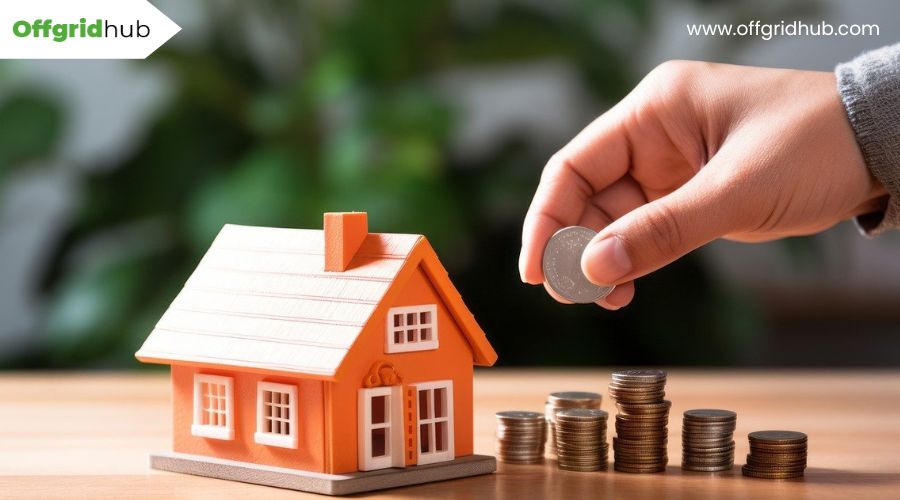You might not be aware that living in a tiny home could significantly bolster your financial health beyond just the lower initial purchase price. Imagine slashing your living expenses, from utility bills to maintenance costs, allowing you to allocate funds towards paying off debt or boosting your savings.
But that’s just scratching the surface. By embracing a minimalist lifestyle, you’re not only cutting down on unnecessary expenses but also paving the way towards a debt-free life. Let’s explore how making this switch could lead to more than just savings, but a profound shift in your financial future.
Substantial Cost Savings
Embracing the tiny home lifestyle can unlock substantial cost savings, offering you financial freedom and a debt-free life. With tiny homes ranging from $30,000 to $60,000, they present a more affordable housing option than traditional homes. This affordability can be especially appealing if you’re budget-conscious or aiming to reduce financial stress. In fact, 65% of tiny home dwellers enjoy the peace of mind that comes with having no credit card debt, a testament to the lifestyle’s ability to curb overspending.
Opting to build your own tiny home can further enhance these cost savings, with self-built models averaging around $23,000. This hands-on approach not only cuts down expenses but also immerses you in a minimalist lifestyle, steering you away from excess consumerism. By choosing a tiny home, you’re not just investing in affordable housing; you’re also committing to a way of life that prioritizes financial freedom over the accumulation of material goods. This shift can significantly reduce your overall living costs, allowing you to allocate your resources to experiences and savings rather than to unnecessary possessions.
Reduced Utility Bills
One of the most significant financial perks of tiny home living is the dramatic reduction in utility bills, often dipping below $20 due to the compact space’s energy-efficient design. The small size of tiny homes, typically under 500 square feet, makes heating and cooling much more affordable. This substantial drop in utility bills is a direct result of the limited space needing less energy to maintain comfortable temperatures.
You’ll find that the savings extend beyond just heating and cooling costs. The smaller square footage and energy-efficient design of tiny homes mean every aspect of your utility bill benefits from lower expenses. With such a reduced need for energy, your overall cost savings on utility bills can be significant.
Living in a tiny home, you’re not just saving money; you’re also embracing a lifestyle that prioritizes efficiency. The limited space isn’t a drawback but an advantage that leads to lower utility expenses compared to traditional homes. This aspect of tiny home living contributes greatly to the overall cost savings, making it an attractive option for those looking to reduce their financial burdens.
Minimal Maintenance Expenses
Beyond the utility bill savings, living in a tiny home also significantly reduces maintenance expenses. The smaller size and fewer systems in place mean you’re not just saving space; you’re also cutting down on the time, energy, and money spent on keeping your home in top shape. Here’s how the tiny living lifestyle translates to lower maintenance costs:
Smaller Size Equals Less Cleaning: With less square footage to cover, you’ll spend less time and fewer resources on cleaning. This simplicity not only frees up your schedule but also your budget.
Fewer Systems, Fewer Repairs: Tiny homes have fewer mechanical systems compared to traditional houses. This means there’s less that can go wrong, reducing the need for costly repairs and replacements.
Simplified Upkeep: The reduced maintenance needs of a tiny home mean you can focus more on living and less on the upkeep. This simplicity is a cornerstone of tiny home living, leading to significant savings over time.
Financial Freedom from Lower Maintenance Costs: The money you’re not spending on maintenance can go towards your savings or other financial goals, offering you a greater sense of financial freedom.
Lower Property Taxes
A major financial advantage of tiny home living is the significantly lower property taxes you’ll likely incur due to the dwelling’s smaller size and lower assessed value. This reduction in property taxes is a direct result of the smaller footprint and lower property value of tiny homes, leading to lower property tax assessments.
| Aspect | Benefit |
|---|---|
| Smaller Size | Leads to lower assessed value |
| Lower Assessed Value | Results in reduced property taxes |
| Location | Savings can vary by local regulations |
| Smaller Footprint | Contributes to lower assessments |
| Financial Benefit | Significant savings on housing costs |
The savings you’ll experience from lower property taxes contribute to the overall cost savings of tiny home living. However, it’s essential to understand that these savings can vary greatly depending on your location and local tax regulations. Despite this variability, lower property taxes remain a significant financial benefit for tiny home owners, offering an appealing way to save on housing costs without sacrificing the joy of homeownership. Remember, the key to maximizing these benefits lies in researching and understanding the specific tax regulations in your intended living area.
Increased Savings Potential
Living in a tiny home can significantly boost your savings potential due to lower overall expenses. When you choose tiny home living, you’re not just opting for a smaller space; you’re embracing a lifestyle that prioritizes financial savings over square footage. Here’s how:
- Reduced Construction Costs: Building a tiny home averages around $23,000. This is a fraction of the cost of traditional homes, allowing you to allocate the surplus funds into your savings.
- Minimal Utility Bills: Tiny homes, by virtue of their size, consume less energy. This means your monthly utility bills can be considerably lower, contributing to more money in your pocket.
- Lower Maintenance Costs: With less space comes less maintenance. Tiny homes require fewer materials and less labor for repairs, adding to your financial savings over time.
- Potential for No Credit Card Debt: A staggering 65% of tiny home owners are free from credit card debt, illustrating the financial stability that tiny home living can offer. This not only reflects prudent financial management but also the potential to build up significant savings for the future.
Debt-Free Living Possibility
By choosing a tiny home, you’re stepping into a lifestyle that not only minimizes your living space but also offers a promising path to debt-free living. The compact nature of tiny homes brings with it a series of financial benefits that pave the way towards a life unburdened by heavy debt loads.
| Benefit | Tiny Home Impact | Financial Outcome |
|---|---|---|
| Credit Card Debt | 65% have no credit card debt | Promotes debt-free lifestyle |
| Mortgage Payment | 68% do not have a mortgage | Reduces financial burdens |
| Cost of Home | Self-built average $23,000 | Offers cost-effective housing |
Living in a tiny home discourages excess consumerism and overspending. With minimal storage space, you’re less likely to spend on unnecessary items, reducing the accumulation of possessions that often leads to financial strain. This lifestyle inherently promotes financial stability, allowing you to focus on what truly matters.
Transitioning to a tiny home can be a strategic move towards achieving financial independence. The cost-effective nature of self-built tiny homes, combined with the reduced inclination towards consumerism, sets a solid foundation for a debt-free living possibility.
Conclusion
By choosing to live in a tiny home, you’re not just downsizing your living space; you’re also cutting down on major expenses. You’ll enjoy significant savings from reduced utility bills, minimal maintenance costs, and lower property taxes. This lifestyle encourages you to live within your means, potentially leading to a debt-free life.
With the extra money saved, you can invest in your future or splurge on experiences rather than things. Embrace the simplicity, and watch your savings grow.


